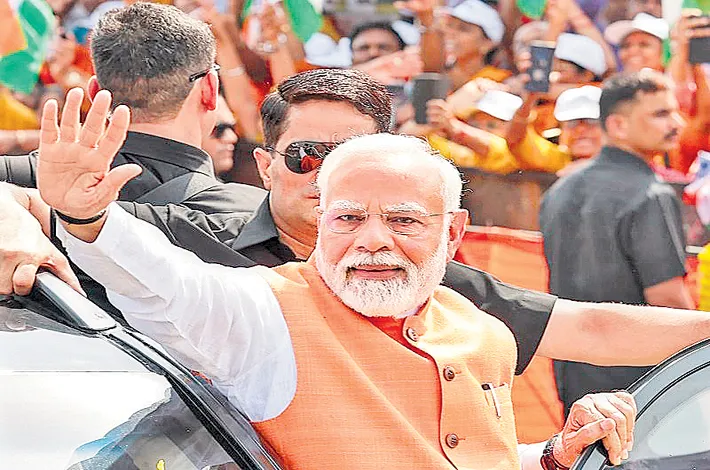The mysterious case of the ill-fated AI Dreamliner
18-07-2025 12:00:00 AM

It is quite intriguing that the government investigative body has selectively revealed data gathered so far without proper context
The controversy over who and what was responsible for last month’s Air India Dreamliner crash grows murkier with every passing day. Criticised for raising more questions than providing answers, the sketchy preliminary enquiry report by Indian investigators by implication points a finger at the deceased pilots flying the plane, absolving the American corporate giants that constructed it. This has triggered a concerted campaign by the Western media, particularly in the United States, to blame the horrific accident that killed 260 people on pilot error.
It is also highly mysterious how sections of the American media reported that investigators of the crash were focusing on the pilots flying the Boeing 787 and not flaws in the aircraft several days before the Aircraft Accident Investigation Bureau (AAIB) officially posted the enquiry report on its website. Incredibly, four days before the report became publicly available in India, but on the same day it was reportedly submitted to the government, a Seattle-based aviation intelligence website, The Air Current (TAC), quoting “multiple people with knowledge of the investigation”, asserted that the investigation into the crash has “narrowed its focus to the movement of the engine control fuel switches following an analysis of the Boeing 787’s integrated flight and voice data recorders”. This is one of the key findings of the preliminary report that said, “Engine 1 and Engine 2 fuel cutoff switches transitioned from RUN to CUTOFF position one after the other.”
TAC went on to claim, “At this point the data available to the investigators did not indicate a mechanical or design issue with the Boeing 787 or its two GE Aerospace GEnx-1B engines.” Amazingly, this is exactly what was implied in the preliminary report, which said, “At this stage of investigation, there are no recommended actions to B787-8 and/or GE GEnx-1B engine operators and manufacturers.”
Two days later, but still 44 hours before the AAIB released its report in India, the Wall Street Journal, a prestigious American business publication, published an exclusive report titled “Air India Probe Puts Early Focus on Pilots’ Actions and Plane’s Fuel Switches”. Significantly, the sub-title read, “Investigation into June crash so far hasn’t pointed to a problem with the Boeing 787 Dreamliner or its GE Aerospace engines.” The journal sourced its scoop to “people familiar with US officials’ early assessments”.
Not surprisingly, once the contents of the preliminary report were made public, the Western media went to town over how this had confirmed previous speculation that it was pilot error, not mechanical or design failure of the aircraft and its engines, that was behind the air crash at Ahmedabad.
The Wall Street Journal was especially jubilant about Indian investigators confirming its scoop, and an opinion piece in the publication a few days after the report was released was suggestively titled “The truth about the Air India crash” with an even more effusive sub-title “Hooray for India’s investigators, who broke the tradition of covering up pilot error”.
This rush to blame the dead pilots of the ill-fated Air India 171 gathered further momentum after an Indian aviation expert and former pilot, Mohan Ranganathan, made the stunning claim on NDTV the day the crash report was released that it was the senior pilot, Captain Samir Sabharwal, who had manually moved the fuel switches to cutoff position to crash the plane. He insisted that this was a deliberate suicidal act by the pilot, who was suffering from mental depression, quoting other Air India pilots, who he failed to name.
However, Ranganathan seemed to be far more defensive three days later, appearing on the same channel in a panel discussion with four other pilots and aviation experts, who unanimously debunked his theory of pilot error as the reason for the air crash. Backtracking on what he had previously said, he now merely suggested that the fuel switches had to be moved manually. Curiously, the aviation expert was conspicuously silent on his earlier unsubstantiated charge of Captain Sabharwal suffering from mental health issues that had been gleefully quoted by media outlets across the West.
Interestingly, Ranganathan, when he was a pilot for Silk Air, based in Singapore, had to leave the organisation in 1998 after he had made a similar allegation against a fellow pilot for deliberately crashing a Boeing 737 flight in December 1997 that killed most of the passengers and crew. The investigation into the crash, carried out by the National Transport Safety Committee (NTSC) of Indonesia, assisted by the National Transport Safety Board of the United States, ended in a split verdict, with the final report clearing the pilot but the American body opposing it. A subsequent criminal investigation in Singapore also absolved the pilot, and so did a judicial inquiry in the US after the victims filed a case for compensation from Silk Air. Ranganathan later became an instructor for the Boeing 737.
The controversy has been fuelled by the confusing contents of the unsigned report and the way it was quietly posted on the AAIB website at 1.30 early Friday morning last week in India, but in time to make headlines for media outlets in the US. Usually, preliminary enquiry reports into air accidents are initial status reports that identify the salient details of the crash, its background and immediate aftermath without disclosing technical details of the investigation in progress. It is quite intriguing that the government investigative body has selectively revealed data gathered so far without proper context, inducing speculation and premature conclusions by interested parties instead of remaining silent till a clearer picture emerged.
For the moment, the government appears to be caught between a rock and a hard place. It is particularly vulnerable to the widespread public backlash palpable on the social media as well as the normally tame mainstream media to the report, which is seen to indict Indian pilots to absolve American corporate giants at a time when the government is twisting and turning to negotiate a trade deal with a bully like US president Donald Trump, known for his bias favouring American industry.








